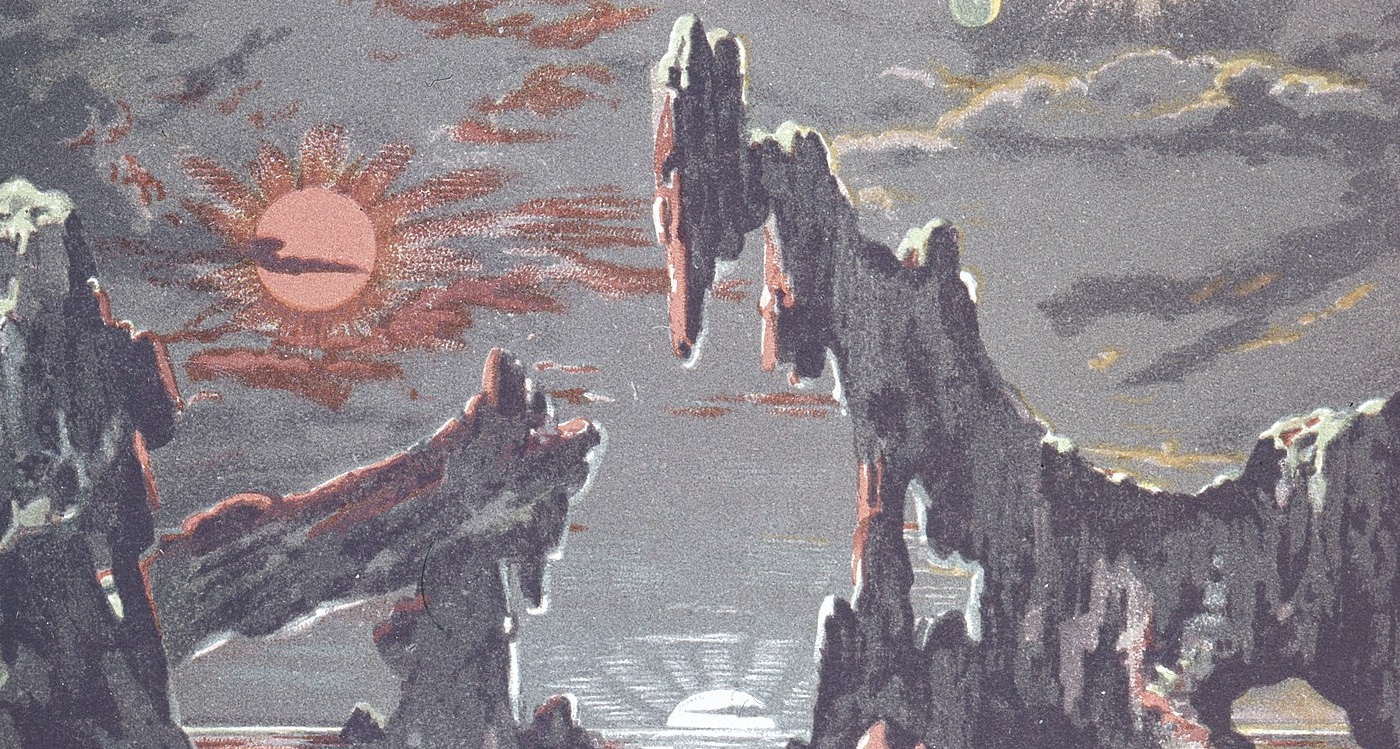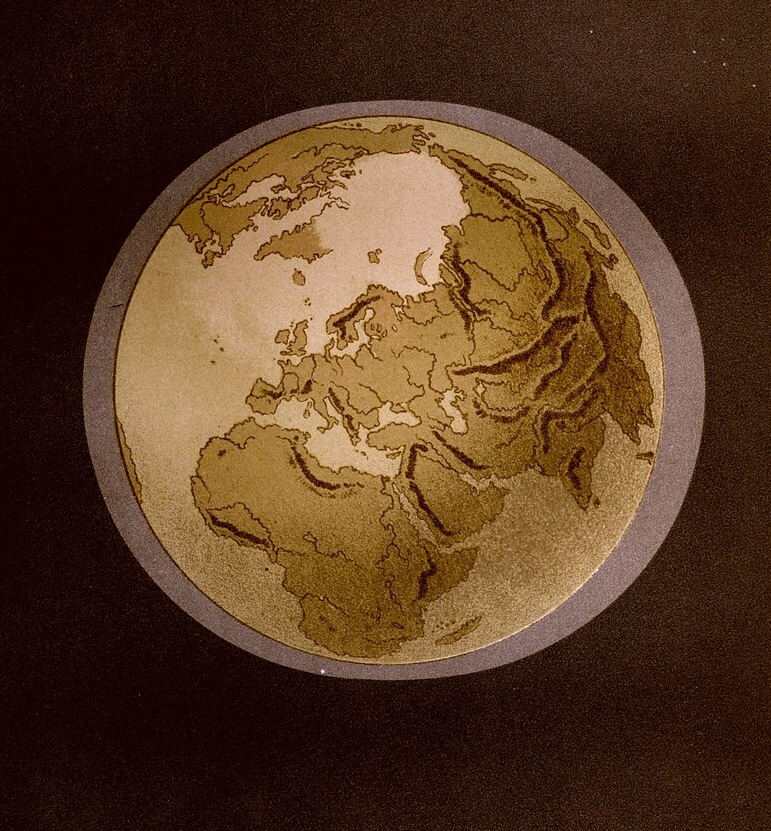Sometimes it is almost impossible to escape a feeling of wonder for the abundance of life in our world. Especially on a summer’s day – when bumblebees buzz among flower petals, grasshoppers play in the dry grass, blue-winged butterflies flutter in the wind. Vegetation stretches from deep underground to the trembling aspen leaf crowns, swifts sail high among cumulus clouds. Life on Earth boasts such diversity. There are over 5.5 million insect species alone, of which a mere million has scientific descriptions. We are not just surrounded by life; we feel it in the pulse of our veins, in the bellows of our lungs. Our life is dependent on the lives of other humans, animals, and plants. We seem to accept that a fly is alive, but a rock is not. But what is the difference, really, between an idle rock in the grass and an irritating fly that we brush off our skin only for it to return? And what do humans and flies have in common that makes us both ‘alive’?
Summer nights are full of life, too, of moths we cannot see and echolocating bats we cannot hear. Each time I look up at the starry sky, especially on clear August nights when the pins of light shine the brightest against that infinite darkness of space, I am struck by an awesome thought. When I look at these stars, I am looking back lightyears in spacetime. And I wonder if maybe, just maybe, far away somewhere among the billions of stars in the Milky Way, there is someone looking back at me at that exact moment pondering the very same questions: ‘Is there life on that planet? What does life look like over there?’ Questions of why life exists, and what life is, are pushed to their limit when we leave Earth for the universe. The search for life in space – the field called astrobiology – is currently focused on the questions of what life is and what it requires to emerge and thrive.
These questions have caused quite a headache for astrobiologists trying to find life, or at least signs of life, on other planets in our solar system and around other stars. They run into similar problems as geologists, palaeontologists and evolutionary biologists searching for the origin of life on Earth. Reaching a satisfactory definition of what life is has proved very difficult. The question has been discussed since antiquity, yet it is one we do not have a unanimous answer to. There has been a plethora of suggestions for a definition throughout the history of biology and philosophy but none that has been able to completely stand firm, that does not have flaws or is either too broad or narrow. We don’t really seem to know what life is.
The mountains, valleys, and plains of the moon as seen through a telescope.
Galileo Galilei, Sidereus Nuncius (Sidereal Messenger), 1610
The intellectual history of life
The history of the concept of life is deeply intertwined with human attempts to understand ourselves and our world. The word itself contains a clue to its meaning. The English word life dates back at least five thousand years to the reconstructed Proto-Indo-European root leip- which means to stick to, or to adhere to. Life is thus a form of persistence, a patient stubbornness. In the original sense, to live is to stay, to persevere, to stick around for a while longer in this world. On the contrary, death is to leave, to pass on, into a different life and world as implied by ancient burial monuments and grave goods. What the dead leave behind are the living.
We find the earliest known explicit definitions of life in ancient Greece. In pre-Socratic philosophy – for Thales, Anaximenes, and Heraclitus of the sixth century BCE – it was assumed that all matter is alive or animated, a school of thought known as hylozoism. Later on, Plato described life as the ability for self-motion. But the ancient philosopher with the greatest impact on the matter is Aristotle of the fourth century BCE. To be alive is to have a soul, he argued, for humans as well as plants and animals. The soul is the form, or eidos, of a living being. When the soul, or form, then leaves the body it ceases to be alive.
The Aristotelian conception of life was dominant for a long time, through medieval scholasticism into the scientific revolution of the seventeenth century. At that point, scientists started to consider circulatory systems as salient properties of life: blood circulation, the respiratory system, digestion, metabolism and the circulation of humours through bodily fluids. Life was not necessarily the possession of a soul, a unique existence, but simply matter in motion. According to this mechanistic explanation, movement itself constituted being alive. Life is movement, death is rest. The living body became a kind of hydraulic-pneumatic machine in accordance with René Descartes’ teachings, like a system of blocks and tackles, funnels and sieves, bellows and other mechanical instruments. Life followed the same mechanical laws as man-made machines.
But what, then, was the spark of life that set the hydraulic-pneumatic machine in motion? In the 1780s Italian scientist Luigi Galvani conducted experiments using dead frog legs, discovering that they started twitching upon exposure to electricity. He concluded that there is a kind of electricity in living creatures, an animal electricity, a vital force that gives life to organic matter. Galvani’s experiment provided inspiration for Mary Shelley’s Frankenstein (1818), in which electricity brings a dead body back to life.
In the early nineteenth century vitalism became the dominant conception of life, which in contrast to mechanism asserted a fundamental difference between lifeless inorganic matter and living organic matter. Mechanists could only explain life in terms of chemical and physical concepts. Vitalists on the other hand, like Friedrich von Schelling and other Romantic philosophers and scientists, argued that chemical and physical properties could not sufficiently describe what life is. They believed in an essential life force, a principle of life, that distinguishes a living body from a dead body.
Both mechanistic and vitalistic studies were conducted in the seventeenth and eighteenth centuries – on life and life processes, the rise and fall of life, and the classifications of life forms – without generating a comprehensive science of life. An umbrella term for the studies of living things was not coined until about 1800: biology, from the Greek word for life, bios, and the affix logía, learning. During the nineteenth century, discoveries in the new field of biology came to alter our understanding of life: the discovery of microorganisms, cell theory identifying the cell as life’s basic structural unit, and comparative embryology. Life was no longer understood as something once created in the beginning of time, but rather a process of ongoing change. We came to see it as a phenomenon of emergence and growth from simple lifeless matter. Charles Darwin’s theories of evolution, natural selection and the origin of the species explained how current life forms have gradually evolved from simpler forms.
Life itself consists of motion.
Carl Linnaeus, 1763
The biological concept of life advanced during the twentieth century through the discovery of genetic code, and DNA and RNA genomes. Yet the riddle of how such organic molecules came into existence from lifeless matter remained unsolved. A number of twentieth century experiments attempted to recreate self-replicating molecules using a mixture of simpler molecules that was believed to exist in the early history of Earth. Although life is thought to follow the fundamental laws of physics, its ordered structure conflicts with the second law of thermodynamics stating that the universe constantly tends toward greater entropy, disorder and chaos. In a physical system, disorder is always more likely than order. In his influential 1944 work What is Life? physicist Erwin Schrödinger argued that life is resistance against the universe’s striving toward chaos. In his view, life is the maintenance of an order, to stand firm, in a world that constantly tries to destroy it. To be alive is to persevere.
One single life
The understanding of life as a natural process in Earth’s history and the discovery of the chemistry of life in genetics have laid the foundation for our modern search for life in space. A central problem in astrobiology is that we only have a single example of life, our own here on Earth. Every form of life known to us has the same origin on the same planet. Flies, humans, bacteria, archaea, and eukaryotes are all related, branches on the same evolutionary tree. Through our common origin, all species share properties that seem to characterize life on Earth. We consist of various carbon compounds and utilize the same specific organic molecules, like nucleic acids, amino acids, carbohydrates, and lipids. We all engage in some sort of energy consumption, or metabolism, that enables growth, change and transformation.
Life is the totality of those set of functions which resist death.
Xavier Bichat, 1800
The most common attempts at a comprehensive definition of life try to set up a complete list of essential properties that make something ‘alive’. Preferably this list is limited yet contains all the necessary and sufficient characteristics shared by living things. It can include chemical building blocks like carbon compounds, water and other elements like nitrogen, phosphorus and sulphur. Environmental conditions can also be necessary: life as we know it only exists on a planet that is temperate enough to have liquid water. This planet must also be of a specific size, that is, have enough gravity to sustain an atmosphere. In addition, it needs to consist of solid ground rather than gas clouds and move in an orbit within the so-called habitable zone around a sun-like star. Common characteristics of Earthly life often included in such lists are structural order and ability for reproduction, growth and development; sensitivity to environmental stimuli and ability to utilize surrounding energy; maintenance of so-called homeostasis (stable and constant internal conditions despite environmental changes); and evolution and adaption. None of these properties are enough in and of itself, but which of them are necessary for life? Is it the ability for reproduction, metabolism, or evolution? Is it consisting of deoxyribonucleic acid (DNA)… or what? The combination of reproduction, metabolism and evolution seem to be at the centre of most attempts to define life.
Alexander Oparin (1961) defined
‘any system capable of replication and mutation as alive.’
NASA’s ‘working definition’ of life, which is one of the most popular definitions, describes it as ‘a self-sustaining chemical system capable of Darwinian evolution’. The advantage of this definition is that it emphasizes life as an evolutionary process rather than a chemical entity. While this may sound good, the definition also jumbles together life in individual entities with life processes in ecological systems. That is a problem NASA’s definition shares with many others, targeting properties that actually exist throughout different levels of life: in an individual, a species, a group, the entire biosphere, or even in the complete history of the biosphere. An individual does not go through evolutionary development, but a population of individuals does. Let’s say we find a microbe floating in the ocean believed to exist under the icecap of Jupiter’s moon Europa and put it under a microscope. We might be able to conclude that the microbe is indeed a self-sustaining chemical system. But how can we know whether it is capable of Darwinian evolution, unless we follow a whole population of microbes and their development for a long time? For astrobiologists, the first part of NASA’s definition – ‘a self-sustaining chemical system’ – is the most practically useful. Our findings should at least in some way deviate from their surroundings, stand out from the constant dull static.
Our central problem remains. We don’t know whether the ingredients on our list are properties that accidentally characterize life on Earth – and only life on Earth – or if they apply to all life that exists and ever can exist. To answer that question, we must find at least one additional example of life. And so far, we haven’t, even though our searches are intense, and our hopes are great to one day come across an indisputable sample of life on another planet.
The tree of life, or the genealogical tree of humanity, according to
Ernst Haeckel, The Evolution of Man: A Popular Scientific Study, 5th ed., 1910
Unknown forms of life
Our definition of life should be narrow enough to exclude things that we intuitively do not think of as living beings. Data viruses have the ability to replicate and other autonomous systems like robots do move about and use energy, but can they really be considered alive? At the same time, our definition cannot be so narrow that it excludes life forms we have yet to know, that may be constructed in an entirely different way than Earthly life. In other words, our definition ought to anticipate future discoveries of life. If we are presented with an interesting finding, our definition should be able to assist us in deciding whether or not it is alive. Otherwise, we risk overlooking potential existing life forms.
One could argue that listing properties of Earthly life does serve a practical purpose, at least as a starting point to our search for life in space. If life once came into being here, why could it not come into being on other places in the universe with similar conditions? If the entire universe shares a single set of physical and chemical laws, the properties of Earthly life should be universal and apply on all planets. According to the Copernican Principle, named after the Polish astronomer Nicolaus Copernicus, Earth does not hold a privileged position in the universe. It is a planet among other planets, with no unique properties except that it is alive. Copernicus only included the six planets in our solar system known at that time. It wasn’t until 1995 that the existence of planets orbiting other stars, so-called exoplanets, was confirmed. Before that there was no decisive evidence that planets even existed outside of our solar system, and certainly no data on their prevalence. Now, studies show that small rocky planets like Venus, Earth and Mars are actually very common, and likely to exist in the habitable zone around the stars they orbit. Among the hundreds of billions of stars in the Milky Way, there are likely many millions of Earth-like planets with the right conditions for life to appear and thrive. As if that wasn’t enough, there are many billion other galaxies with their own innumerable stars and planets.
Life is not the sort of thing that can be successfully defined. In truth, a definition of life is more likely to hinder than facilitate the discovery of novel forms of life.
Carol Cleland, 2019
Describing our planet as a common and relatively ordinary place in this enormous universe opens up the possibility of an ‘Earth twin’ where life can exist. Astrobiology often utilizes such analogical reasoning, going from the known to the unknown. Using life as we know it as a starting point, we travel into space. Astrobiologists look for carbon-based life that needs liquid water and inhabits a planet of an Earth-like size, with an Earth-like gravitation, atmosphere, chemistry and temperature. The planet should also orbit a star similar to our sun, around 4.5 billion years old, in a certain orbital period and at a certain axial tilt and distance within the habitable zone.
If Earth has a number of properties that create the right conditions for life, analogical reasoning suggests that we are likely to find life on other planets with similar properties. Our challenge, then, is to choose which properties, out of an almost infinite array, are correct and relevant. A common historical mistake in astrobiology is the assumption that necessary conditions are the equivalent of sufficient conditions. If liquid water is necessary for life as we know it, it is just one of many necessary conditions needed for a planet to be considered inhabitable. Since we don’t know each and every necessary and sufficient condition required for life to exist, we might conclude that a planet is inhabitable but not that it’s inhabited.
Analogical reasoning offers a starting point to our search, but the ‘big analogy’ of astrobiology doesn’t prove anything except a theoretical possibility of life in space according to current scientific knowledge. Not even a billion ‘Earth twins’ would give us better or more conclusive evidence that life actually exists on them. One single living planet, our Earth, is quite a meagre starting point from which to reach an inductive conclusion.
The continuum of life
A definition of life that attempts to distinguish living things from non-living things must also be able to handle the in-between – an uninterrupted continuum in evolutionary history from lifeless molecules to living beings. Astrobiologists and palaeontologists search not only for living things but also for things that have died like fossils and traces of previous environments conducive to life. Our understanding of life and its origin as a biochemical evolutionary process, rather than an inexplicable act of God, indicates a gradual development from lifeless matter to more complex life forms. Life creates long continuous chains of genetic information stretching through the passage of time. So where do we draw the line between living and dead matter? What makes a chemical composition ‘alive’? Are life and death binary concepts with a clear, discrete distinction? We like to categorize things as such, as either a chair or not a chair. It cannot be both a chair and not a chair at the same time. Same thing goes for life. Something is either alive or it is not. A similar problem is found in the species concept, which was constructed to capture common traits of a population at one moment in time – even while it journeys through the continuous, never-ending transformation of evolution.
There are life forms on the continuum between living and non-living beings that share some, but not all, characteristics with creatures we definitely consider to be alive. Viruses are a prime example of such liminal spectres that trip up scientists. Viruses share several traits with living organisms; they are structurally organized, change over time, consist of organic matter, have genomes composed of RNA or DNA, and go through natural selection. But most biologists do not consider viruses to be alive since they lack a cell structure of their own and the ability for metabolism. In addition, they are not able to reproduce outside of the infected host cell and rather free-ride on the machinery of their surroundings to create more viruses. Those who argue that viruses should be considered alive emphasize their ability to reproduce and evolutionarily adapt to their environment. This camp also points to the genomic similarities between viruses and other organisms in the tree of life, indicating a kinship. If life is a dynamic process, a continuum from non-life to life, perhaps we ought to speak of ‘degrees of life’, of organisms that are ‘more alive’ or ‘less alive’?
The existential question
Are we alone in a lifeless, desolate universe? I like to believe that life exists on a million planets and emerge wherever it is able to. It might not be intelligent life, more likely simple microbes. Intelligent life, an organism’s ability for self-consciousness, may be nothing but a blip in the history of the universe. A self-destructive characteristic, in which our technical powers to destroy the conditions for life outweigh our ability for self-reflection.
I do not envisage life as an isolated entity but as something that constantly interacts with its surroundings, with other living and non-living things. It is a continuous process that enables an increase in order and complexity, a dynamic chain of events that lingers, stays put, in this world of chaos and disorder. In other words, life is the creation of order at the expense of the disorder of its surroundings – thus maintaining the second law of thermodynamics stating that the universe constantly tends toward greater entropy.
If we find extraterrestrial life one day, it is very likely to fundamentally alter our concept of what life is and can be. What’s more, maybe it will change our answer to the existential question of what it means to be alive.
Earth as seen from the moon (La pleine terre, vue de la lune).
Astronomie Populaire, Camille Flammarion, 1889.









